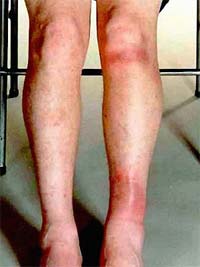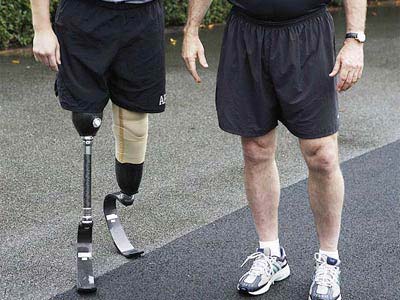People with diabetes often cut spending by gangrene if unfortunately they encounter scratch. There have been new treatments for them to avoid this tragedy: High pressure pumps blood to the injured limb.
The construction of a new medical technology is Dr. Rodney Lane, vascular surgeons Royal North Shore Hospital in Sydney. The new technique was officially announced on 08.08.2007, was the first to help a patient avoid cutting out a leg. It was Malcolm Brown, 52, of Newcastle, Australia.
High pressure pumps blood into the injured limb peripheral vascular
disease by the new method of Australian experts to increase blood flow
to the extremities, stimulate the development of new blood vessels,
prevent necrosis leading to the to cut spending.
 |
New treatments can help hundreds of thousands of diabetics to avoid the risk of amputation surgery. (Photo: Patient.co.uk)
|
According to Dr. Lane, clinical trials have been performed successfully in his leg Brown 1 year ago. Previously, Mr. Brown was 3 doctors announced that he needed surgery to remove a gangrenous leg.
The man had two children were peripheral vascular disease, leading to
the formation of a thrombus (clot) in the arteries near the knee,
causing severe congestion of blood supply to the leg from the knee down. Dr. Lane said: "At the time, Brown had his foot numbness and became cold and white as anemia. The necrotic lesions formed on the feet and toes. "
With no hope leg amputated, Mr Brown agreed to participate in the testing of new techniques.
Doctors implanted femoral artery in patients with a small device with pen, called Peripheral Access Device (PAD), that "access peripheral devices." The device is connected to a pump Blood placed outside the body.
Then, the patient's blood is pumped through the leg with a high
pressure, helps increase blood flow to the leg 2.5 times the amount of
blood pumped from the heart, thereby stimulating the development of new
blood vessels.
In a statement, Dr. Lane said: "After 50 hours of pumping is done in 5 days, the patient's leg had become warmer and rosy again. The feeling in the legs also significant recovery and ulcers on the feet and toes began to heal faster. "
He said: "Truth of the patients were rescued by the growth of blood vessels of the patient, thereby restoring blood supply to the legs. A year later, his legs Brown remains intact and he could walk. "
Currently, Mr. Brown is encouraging patients at risk for amputation
volunteers participating in the trials are still continuing at the Royal
North Shore Hospital.
 |
Diabetes
and smoking are two common causes of peripheral vascular disease -
disease resulting in approximately 340,000 cases of amputation in the
West each year. (Photo: img.timeinc.net)
|
Dr. Lane said: "This
success opened up tremendous hope for approximately 340,000 patients
underwent amputation surgery annually in Western countries due to
peripheral vascular disease."
According to medical experts, diabetes and smoking are two common
causes of peripheral vascular disease - disease resulting in
approximately 340,000 cases of amputation in the West each year.
Speaking to AFP, Greg Roger, assistant professor of bioengineering at
the University of Sydney, CEO of the company manufacturing equipment
PAD, said he hopes to have more clinical trials from now the end of the
year, so this method can be formally applied to patients at risk of
amputation.



0 comments:
Đăng nhận xét